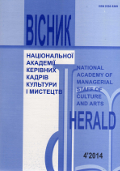РЕЛІГІЙНО-ЕСТЕТИЧНИЙ ДІАЛОГІЗМ І СИНКРЕТИЗМ В АРХІТЕКТУРІ УКРАЇНСЬКОГО КОЗАЦТВА
Religious and aesthetic dialogism and syncretism in architecture of ukrainian cossacks
Author(s): Victoriia Mykolayivna PishchanskaSubject(s): Cultural history, Customs / Folklore, Architecture, Ethnohistory, Cultural Anthropology / Ethnology, Eastern Orthodoxy
Published by: Національна академія керівних кадрів культури і мистецтв
Keywords: spiritual culture; Ukrainian Cossacks; architecture; Cossack Baroque, the Orthodox religion; religious and aesthetic syncretism;
Summary/Abstract: The features of Baroque architecture of Prydniprovia are reviewed. The role of the Orthodox religion in cultural processes that occurred in Ukraine during the XVII – XVIII centuries, influenced by Baroque trends and phenomenon of Ukrainian cossacks is analyzed. The influence on the aesthetic ideas of the formation of cossack architecture is researched. The stylistic analysis of Cossack architecture monuments is made. It opens the possibility to confirm its authenticity, uniqueness and originality.The author admits that the churches, cathedrals, temples of the XVII – XVIII centuries in Prydniprovia formed the original authentic style where closely intertwined the unique features of Ukrainian national culture with the baroque stylistic features. The fundamental factors in its formation were historical events and the phenomenon of Ukrainian cossacks. The cossack element and canons of martial fraternity led to the emergence of particular ethnic style – Cossack Baroque style. We can see its unique features in the special aesthetics, based on profound religiosity of Ukrainian Cossacks. The research of cossack art, including its spatial forms provide opportunities for understanding those peculiarities of Ukrainian culture that are the indicators of Ukrainian spiritual culture of the XVII – XVIII centuries. The author focuses on the ratio of religious and aesthetic factors and their interpenetration in the architecture of Ukrainian cossacks.The author states that the internal integrity of the Cossack art and the role of the church as its highest display determine the unity of the struggle for the freedom and the faith that inspired the cossacks and dictated the need of ideal. A church in the culture of the Ukrainian cossacks is the aesthetic embodiment of ideal of people spiritual unity, the embodiment of all kinds of handicrafts. In the Cossack attire and appearance we see the national original combinations of aesthetics and ethics, goodness and beauty categories combinations. Among the Ukrainian churches of Cossack era is impossible to find two identical ones, each has its own character, caused by innate fascination of people by the beauty, by great potential strength, by invincible necessity to create, and the most important it is caused by the Cossacks aesthetic ideals and religious principles.The combination of ethnic items in the Cossack Art with the stylistic features of Ukrainian Baroque is laid in the base of general principles of sacred building in Zaporizhzhya region and concerns the whole monuments, which gives them the certain characteristics. Undoubtedly, the artists of the XVII – XVIII centuries solved the problems of architectural creativity by using the Baroque basis and changing their architectural beliefs. The Cossack architects worked in the conditions of free creativity, they were not limited by prepared formulas and rules. In this regard, in the architecture of the Ukrainian Cossacks we mention the emergence of the new stylistic features, observe the formation of the new baroque aesthetics, based on the use of unusual means of space design, the formation of special architectural concepts and the implementation of the original architectural logic of volume and space shapes. The author makes the conclusions that the unique architecture of the Ukrainian Cossacks is based on the simultaneous superposition of cultural and historical factors, stylistic and national traditions, with comprehensive penetration of aesthetic trends that are typical to the Baroque style. It stipulated the religious and aesthetic syncretism in the architectural art in the Cossack period.
Journal: Вісник Національної академії керівних кадрів культури і мистецтв
- Issue Year: 2014
- Issue No: 4
- Page Range: 32-37
- Page Count: 6
- Language: Ukrainian

